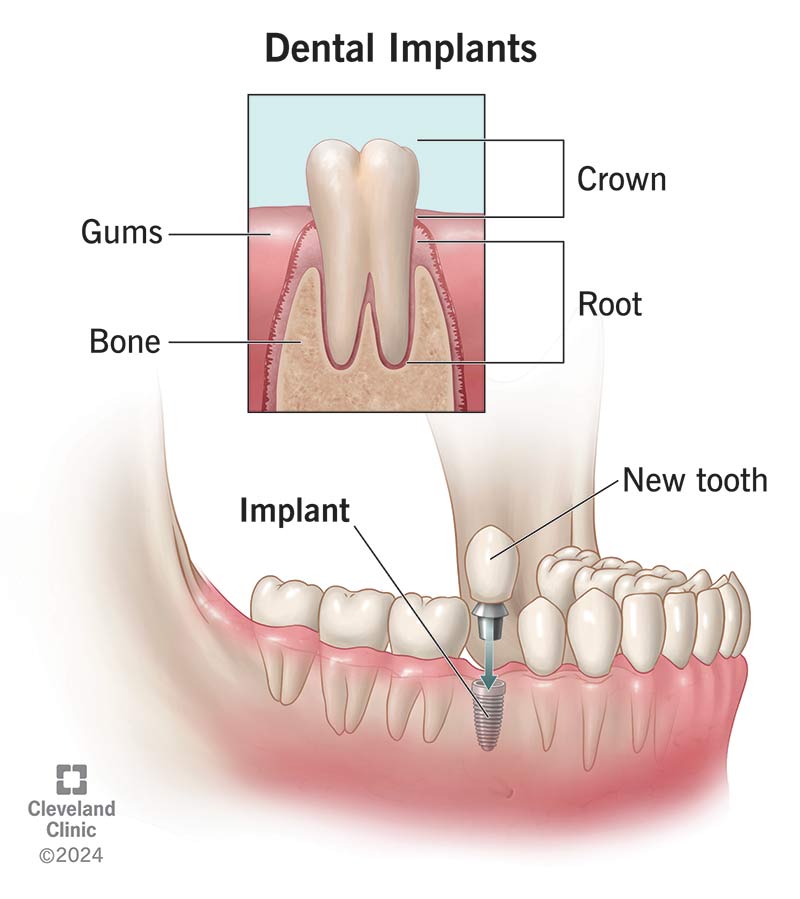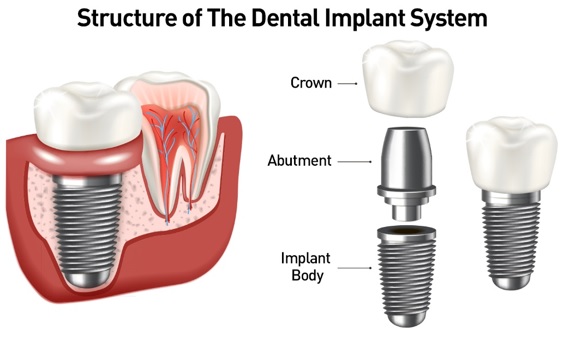All About Dental Implants
All About Dental Implants
Blog Article
The Greatest Guide To Dental Implants
Table of ContentsThe 5-Second Trick For Dental ImplantsThe 30-Second Trick For Dental ImplantsLittle Known Facts About Dental Implants.Some Of Dental Implants
are clinical gadgets operatively dental implanted right into the jaw to restore an individual's capability to chew or their look. They provide support for man-made (fake) teeth, such as crowns, bridges, or dentures. When a tooth is lost due to injury or condition, a person can experience problems such as rapid bone loss, malfunctioning speech, or changes to chewing patterns that cause pain.
Structure of The Oral Implant System picking dental implants, speak with your dental service provider about the possible advantages and dangers, and whether you are a prospect for the procedure. Things to think about: Your general health is a vital element in identifying whether you are an excellent prospect for oral implants, for how long it will take to heal, and how much time the dental implant might stay in location.
Smoking might impact the recovery process and decrease the long-term success of the dental implant. The healing procedure for the implant body may take a number of months or longer, during which time you normally have a temporary joint in location of the tooth. the dental implant procedure: Thoroughly follow the oral hygiene guidelines given to you by your dental service provider.
Some Known Details About Dental Implants
Implant failing can cause the need for another surgery to repair or replace the dental implant system. Brings back the capacity to eat Restores cosmetic look Aids keep the jawbone from reducing because of bone loss Maintains the wellness of the surrounding bone and gum tissues Aids maintain surrounding (neighboring) teeth steady Improves lifestyle Damage to bordering natural teeth throughout implant positioning Injury to the surrounding cells during surgical treatment, such as sinus perforation Injury during surgical procedure (for instance, fracture of surrounding jawbone) Poor function, such as feeling like the teeth do not attack together generally A sensation that the tooth hangs or twisting in position resulting from a joint screw loosening Implant body failing (looseness of the dental implant body) as a result of systemic infection, which might be more probable in people with unchecked diabetes mellitus due to local infection in bone and periodontals supporting the implant body because of delayed recovery, which might be more their website likely in patients that smoke Trouble cleaning the gum tissues around the implant, leading to inadequate dental health Neglected gum disease Post-surgical tingling due to nerve impingement or damages Constantly alert healthcare carriers and imaging professionals that you have oral implants prior to any magnetic vibration imaging (MRI) or x-ray procedures.
FDA is not knowledgeable about any type of adverse occasions reported for MRI or x-ray treatments with oral implants. Oral implants systems are usually constructed from materials that comply with international consensus standards of the International Company for Standardization (ISO) or ASTM International. These you could try this out criteria have details of what makes a safe product.
Oral implant systems are evaluated according to global consensus requirements. Biocompatibility testing, to show that physical contact with the tool does not create complications like irritability or allergic reaction, is component of the assessment that aids make sure the products in the dental implant system are safe and do not trigger damaging results when implanted in people.

The Greatest Guide To Dental Implants
Some individuals are not eligible for oral implant surgery. It is for oral doctors to operate on people with: intense illnessuncontrollable metabolic diseasebone or soft cells disease or infectionIf these problems are fixed, an individual can have the surgery. Dental Implants. In, dental specialists refrain from operating individuals with: If individuals with any of the above undergo dental implant surgical procedure, there is a higher danger of the dental implant stopping working
Some individuals have a jawbone abnormality that prevents enough bone for an implant from developing. In such instances, a surgeon may need to do a ridge alteration. This includes lifting the gum tissue to reveal the area of deformed bone. The page doctor will certainly then make use of a bone or bone alternative to fix and develop up the area.
Dental implant surgery is a personalized procedure. It's not the same for everyone. But the following gives a basic introduction of what you can anticipate your dentist, dental doctor, periodontist or prosthodontist to do: Place the implant operatively. Provide you time to heal. Connect the message and last crown, bridge or denture.
Next off, your surgeon will very carefully put the oral implant into your jaw. If your dental implant is near the front of your mouth, your dental expert will make a temporary tooth for you to put on up until you recover.
Excitement About Dental Implants
Your supplier can tell you what to expect in your situation. During the recovery stage, your jawbone should fuse to the oral implant. This process, called osseointegration, is essential for stability and long-term success. This process can take anywhere from 3 to nine months. In many cases, it may take much longer.
Once your implant heals, your dental practitioner can connect the joint (tiny adapter message) and your last restoration (crown, bridge or denture). This typically takes concerning one hour to finish and may call for a 2nd minor surgical procedure. You should not feel any pain throughout your dental implant treatment due to the fact that your provider will certainly make use of medicine to numb your periodontals.
Report this page